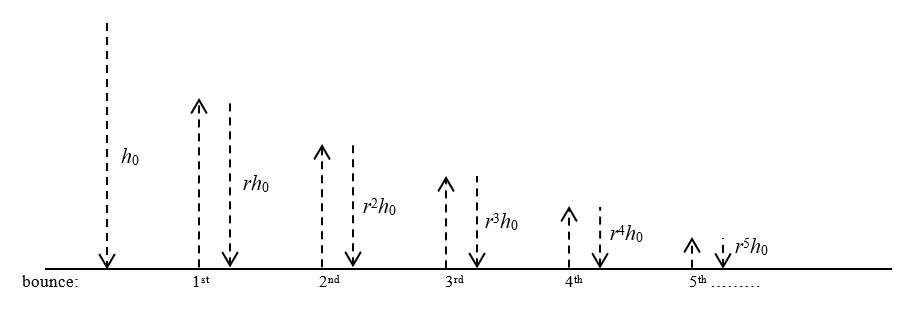Bouncing Ball Problem Revisited
A well-known problem one may encounter is the bouncing ball problem. A ball is dropped to the ground from a height of h0. Based on its elasticity, it bounces back to a height of r times the height it was dropped from, where 0 < r < 1. This produces the well-known geometric series with each bounce.
Problems: (1) Find the total distance traveled by the ball. This is easily solved. (2) Find the time it takes before the ball stops bouncing. This is the challening part that will require some physics.

Finding the Total Distance Traveled
We can find the total vertical distance, dT, the ball travels until the ball stops by summing the distances of each bounce.
(i) $d_{\text{T}} = h_0 + 2rh_0 + 2r^2h_0 + 2r^3h_0 + 2r^4h_0 + 2r^5h_0 + ...$ (for 0 < r < 1)
This is a geometric series with the common ratio r. The sum and the total vertical distance traveled by the ball is therefore:
(i) $d_{\text{T}} = h_0 + \frac{2rh_0}{1-r} = \frac{1-r}{1+r}h_0$ (for 0 < r < 1)
If a ball is dropped from an initial height of h0 and the ball bounces back up a factor of r of the previous height after each bounce thereafter, then the ball travels a total vertical distance, dT, of $d_{\text{T}} = \frac{1-r}{1+r}h_0$ for 0 < r < 1.
Finding the Total Distance Traveled
Finding the total distance traveled by the ball is fairly simple, as we have just done. However, to find the total time it takes the ball to travel that distance is the more challenging task. Since we know that the total distance traveled in finite, the total time has to be finite also.
To begin, we first assume that the only force acting on the ball is that of gravity. We can use the equation for falling objects and concepts of kinetic and potential energy to find the total time.
The equation for falling objects is $s(t) = \frac{1}{2}\mathbf{g}t^2 + v_0 t + h_0$, where g is the gravitational constant –9.81 m/s2, v0 is the initial velocity, and h0 is the initial height. The position function s(t) denotes the position of the object, or the height of the object measured from the ground.
The initial height of the ball is kept general h0 and the initial velocity is 0 since it was dropped. Therefore, the time it takes to make the first bounce is when s(t) = 0. We can find this easily by solving for t in the position equation:
(iii) $0 = \frac{1}{2}\mathbf{g}t^2 + h_0$
(iv) $t_1 = \sqrt{\frac{2h_0}{g}}$
In equation (iii), t1 is the time it takes for the first bounce and g in the square root denotes the positive value of g. (Remember that g as a constant has a negative value, but g can be positive or negative.)
Now, in order to find the time it takes the ball to bounce back up and then make the second bounce, we need to know the initial velocity of the ball as it bounces up from its first bounce. In this case, the initial velocity is not 0. If it was 0, the ball wouldn’t bounce back up. We use the relationship of potential and kinetic energy to find the initial velocity.
When the ball makes its first bounce, all its energy is kinetic energy. As it travels up, it loses its kinetic energy, and therefore its velocity continues to decrease until it reaches its maximum height (which is rh0) when its kinetic energy and velocity are 0. But the ball has gained potential energy due to its height. Since the ball rises to a height of rh0, the potential energy of the ball is given by mgrh0, where m is the mass of the ball. The potential energy at its maximum height is equal to the kinetic energy at height 0 where the ball makes its bounce. Therefore:
(v) $\frac{1}{2}mv^2 = mgrh_0$ or $v = \sqrt{2grh_0}$, (where v is the initial velocity of the ball during its first bounce)
The mass of the ball canceled out and the velocity is independent of the mass.
Therefore, the travel time of the ball between the first and the second bounce can be found by solving for t in the equation: $0 = \frac{1}{2}\mathbf{g}t^2 + \sqrt{2grh_0}$. The initial height this time is 0 since the ball was launched from the ground. Solving for t, we obtain the travel time between the first and the second bounce to be:
(vi) $t_{1,2} = 2\sqrt{\frac{2rh_0}{g}}$
Another way to come to this conclusion is to realize that the landing velocity of the ball is equal to the initial velocity after each bounce.
The time between any two bounces can be generalized by using this fact. The ball undergoes freefall after it reaches a maximum height of rmh0 after the mth bounce. Thus the equation of the ball falling to the ground after reaching the maximum height is $s(t) = \frac{1}{2}\mathbf{g}t^2 + r^{m}h_0$. If we let tm,(m+1) be the travel time of the ball between its mth and (m + 1)th bounce, then solving for t gives:
(vii) $t_{m,(m+1)} = 2\sqrt{\frac{2r^{m}h_0}{g}}$
Therefore, the sum of the times is the total, tT time it takes the ball to travel the distance until it stops bouncing:
(viii) $t_T = \sqrt{\frac{2h_0}{g}} + 2\sqrt{\frac{2rh_0}{g}} + 2\sqrt{\frac{2r^{2}h_0}{g}} + 2\sqrt{\frac{2r^{3}h_0}{g}} + 2\sqrt{\frac{2r^{4}h_0}{g}} + ...$
Notice that the series is a geometric series with common ratio of $\sqrt{r}$ after the first term. Therefore, the sum is:
(ix) $t_T = \sqrt{\frac{2h_0}{g}} + \frac{2\sqrt{\frac{2rh_0}{g}}}{1-\sqrt{r}} = \sqrt{\frac{2h_0}{g}}\left(1+\frac{2\sqrt{r}}{1-\sqrt{r}} \right) = \sqrt{\frac{2h_0}{g}}\left(\frac{1 + \sqrt{r}}{1-\sqrt{r}}\right)$
If a ball is dropped from an initial height of h0, and it bounces back up by a factor of r of the previous height after each bounce thereafter, then the time, t, the ball will bounce before the ball stops is $t = \sqrt{\frac{2h_0}{g}}\left(\frac{1 + \sqrt{r}}{1-\sqrt{r}}\right)$ seconds, where 0 < r < 1.

 Conic Sections
Conic Sections